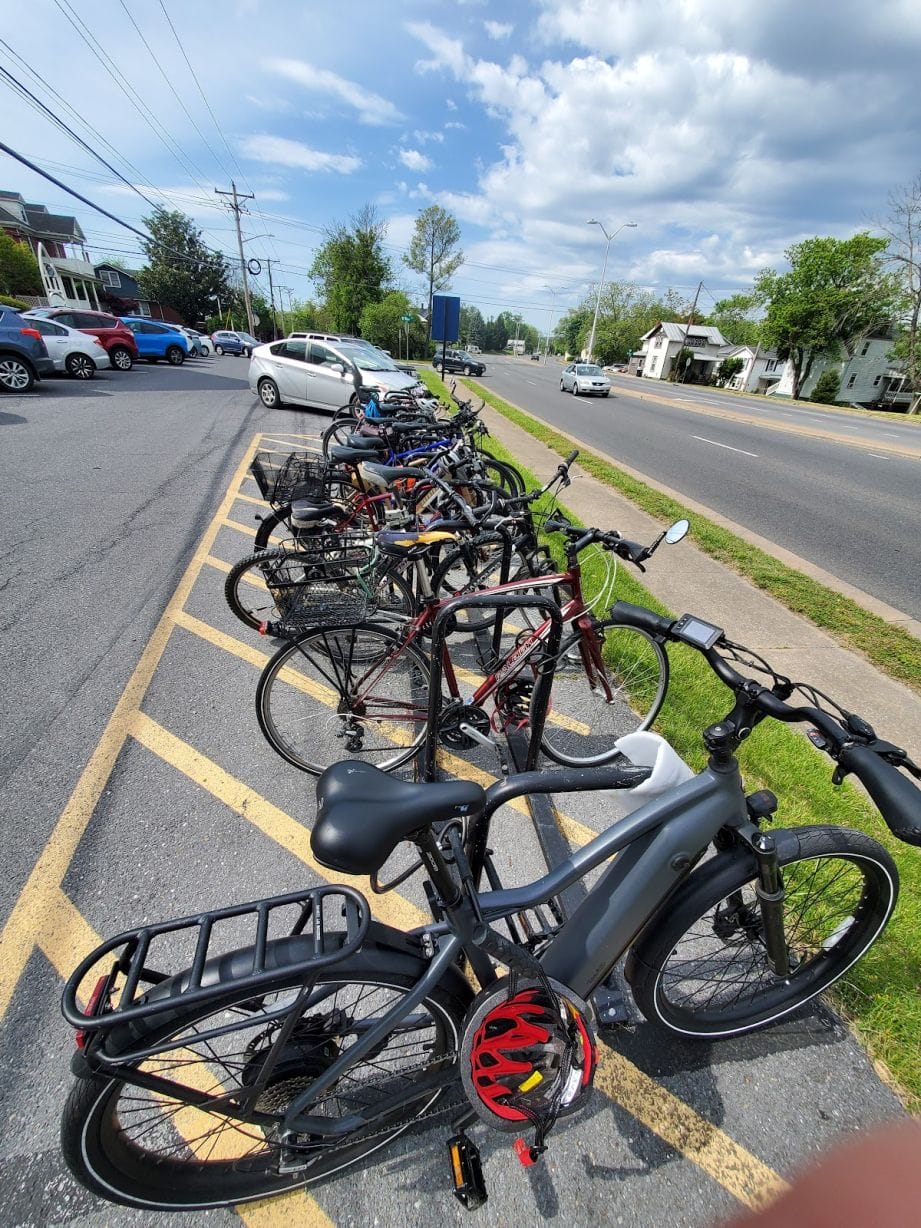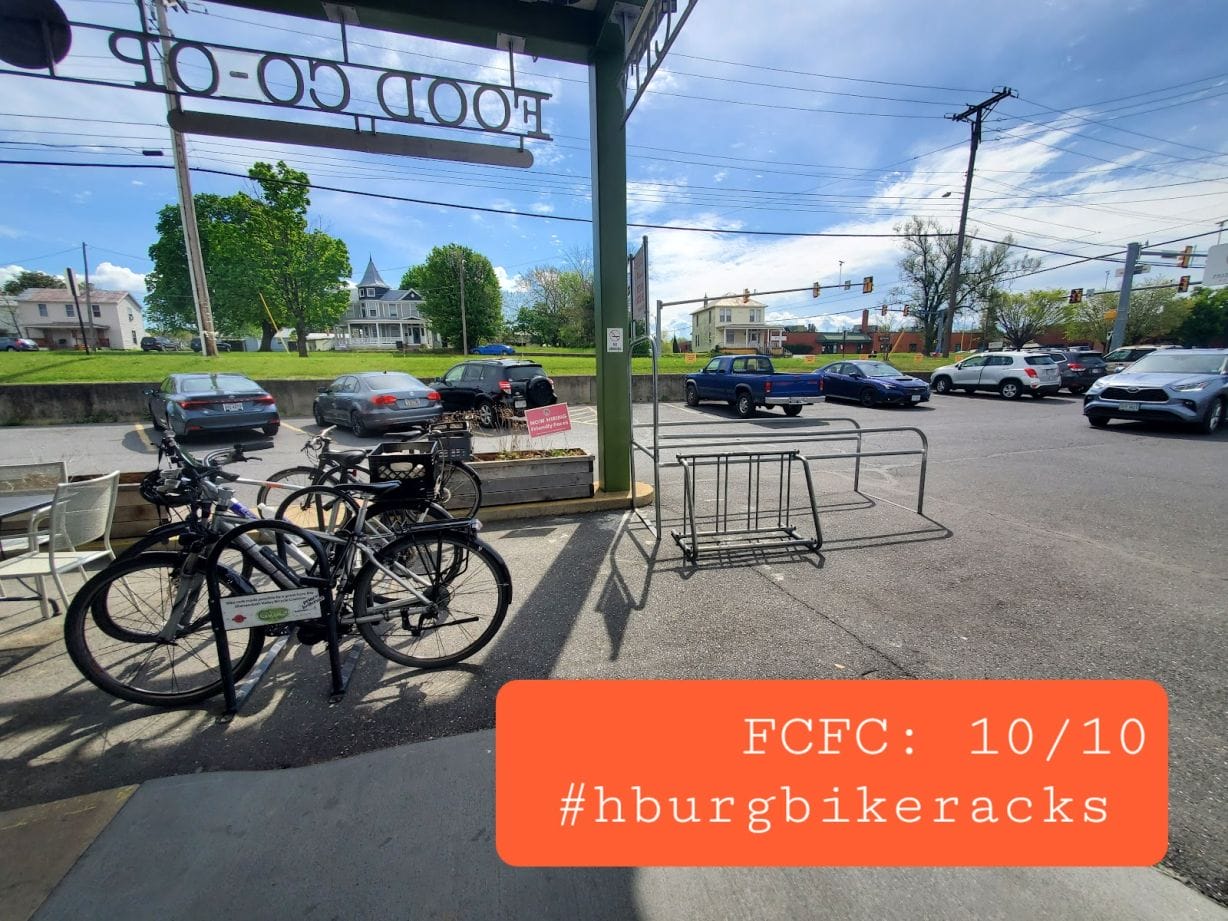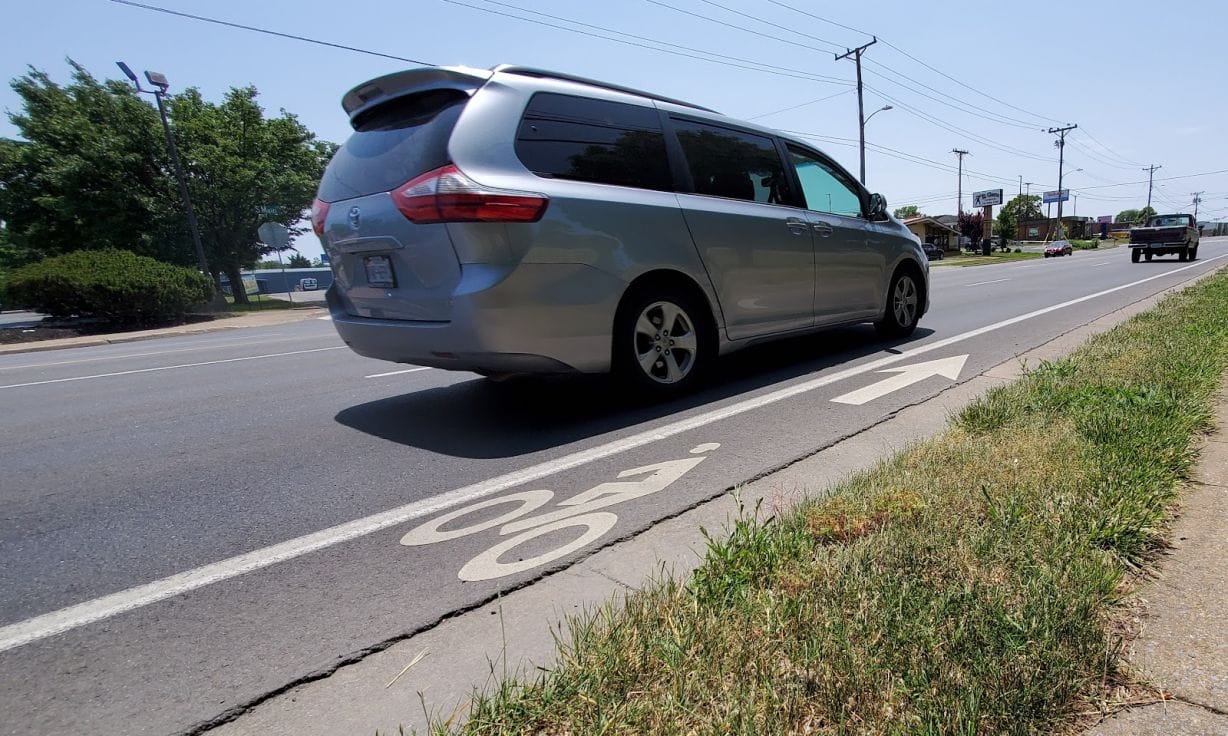A contributed perspectives piece by Brent Finnegan
I was two-thirds of the way up the hill on Paul Street headed toward Ott when I couldn’t pedal any farther. I dismounted my bike and commenced the walk of shame up the remainder of the hill. When I reached the summit of Old Town hill I waited until I had enough oxygen in my blood before continuing on to a work meeting that was about to start in 10 minutes.
A few weeks earlier I had made a personal commitment to commute to work by bike for the sake of driving less. Not only is transportation the number one source of greenhouse gas emissions in the US, but continuing to prioritize car storage in the midst of a housing and climate crisis is an unconscionable misallocation of land. Health concerns are also a motivating factor: driving tends to bring out the worst in us, while studies have shown cycling for transportation improves our physical and mental health.
During the June 2022 meeting of the Harrisonburg Planning Commission I publicly pledged not to drive to our monthly meetings for one year. But is it even possible to ditch your car for a bike in a city as car-centric as Harrisonburg? Gasping for breath at the top of Paul Street that day, I had my doubts.

Photos courtesy of Brent Finnegan
I have a perfectly adequate Trek bike that has served me well for weekend afternoon rides to the park, rails-to-trails trips, and the occasional Wednesday night hburgsocialride. There’s just one problem when it comes to using a bike for my daily transportation needs: Harrisonburg has hills and I’m not athletic. I’m neither a mountain biker nor a long-distance road cyclist. When I look at a bike I don’t see a mobile exercise machine, I see a means to go short distances and run errands without having to drive a car.
After arriving at more than a few work and Zoom meetings sweaty and out of breath, I had to reconsider my approach to living car-lite. A year earlier I had rented an electric bike while traveling. I enjoyed the experience of pedaling uphill, feeling like someone was pushing the bike from behind.
Are ebikes “cheating?”
A couple hardcore cyclist friends have suggested that ebikes are “cheating,” or have expressed concerns about the lithium batteries used in ebikes. Walking or riding a good old-fashioned bicycle are undoubtedly the lowest-carbon transportation options available, and if Harrisonburg were flat, I probably wouldn’t be interested in ebikes. If you are physically able to commute regularly on an “acoustic” bike in the Shenandoah Valley, more power to you (figuratively). For the rest of us who would otherwise be commuting on four wheels, ebikes are a great space-efficient, low-carbon alternative.
While electric car batteries keep getting larger, exacerbating the environmental harm caused by lithium mining, ebikes are a fraction of the cost and use a fraction of the resources of an electric car. Electric bikes have power assist settings that allow the rider to get as much or as little exercise as desired, and importantly don’t take up a 9-by-18-foot parking space. If electric motor-assisted micromobility is “cheating,” what does that make commuting in a four-wheel fossil fuel-powered vehicle?
Expensive compared to what?
If you’re expecting a price point similar to the last bike you bought, ebikes will look pricey. The initial sticker shock at the prices for premium ebikes ($3,000 to $7,000) led me to search the lower end of the price spectrum (under $2,000). However, if an ebike is taking the place of a car, that changes the equation. Ebikes are among the cheapest modes of transportation, particularly when you take into account unpredictable gas prices or the cost of EVs (even with the tax credit).
After I had taken a few different models for a test spin at Mole Hill Bikes in Dayton, I bought the class 3 Aventon Pace 500 for $1,500 (the equivalent of a few monthly car payments). Soon after that, my spouse and I took the leap and sold one of our two cars. I’ll qualify that by adding we don’t have kids, my spouse works from home, and my office is less than a mile from our house. In other words, we’re in an optimal position to go car-lite.
Most trips are short
Data from the Bureau of Transportation Statistics show that 52% of all trips Americans take are less than three miles. 28% are less than one mile, and only 2% of all trips are greater than 50 miles. I commute to work by ebike four or five days a week and have only logged 500 miles on my odometer in the first year. I need to charge the battery maybe once every two or three days. My cumulative mileage suggests trips in Harrisonburg may be even shorter than the national average.
When I attend meetings downtown or on JMU campus, biking can actually save time: instead of searching for parking or winding my way up a multi-story parking deck and walking, I’m locking up my bike a few steps from the front door of my destination. Another unanticipated benefit: I’ve had far more impromptu conversations with my neighbors that wouldn’t have happened if I was driving a car. Where cars tend to keep us isolated from one another, bikes open up new opportunities for human connection.
Neither snow nor rain
The Danish saying, “There’s no such thing as bad weather, only unsuitable clothing” applies to cycling in the Shenandoah Valley. I learned the hard way that my lightweight Columbia rain jacket is merely water-resistant, so I bought a used waterproof raincoat on eBay, and found some zip-on rain pants at Gift & Thrift. Riding in light to moderate rain isn’t a big deal. For the occasional downpour, I’ll either wait it out or drive if I must.
Depending on topography, ebikes can go up to 28 miles per hour, so cycling glasses are a must regardless of the weather. My waterproof backpack has come in handy for toting a laptop, lunch, coffee, and papers to work. During colder weather, if a base layer, coat, scarf, and gloves aren’t enough to keep me warm, I simply lower the assist level to raise my body temperature. I was able to continue commuting to work via ebike all winter long.
Cars aren’t customers
For the most part, local businesses in and around downtown do a great job of accommodating customers who bike to their store. Ten or more bikes can fit into one 9-by18-foot car parking space. That’s ten times the potential customers for one parking spot, a much more efficient use of limited land. Not all bike racks are created equal, and it’s not just ebikes that don’t fit in the traditional schoolyard grid racks. Many cargo bikes aren’t electric, but still don’t fit in the older grid racks. U-racks remain the undefeated champions: as bikes change, U-racks will continue to accommodate all different styles, shapes, and sizes.
Not all customers drive cars, but you wouldn’t know that by looking for a place to lock your bike at some of the shopping centers and strip malls in town. More than once I’ve been faced with the choice to lock my bike to an accessible parking signpost or take my business elsewhere. I’ve been documenting and rating the bike parking facilities of various destinations in Harrisonburg on Instagram using the hashtag #hburgbikeracks.

Bike lane ends
Considering the amount of signage about bike lanes in Harrisonburg compared to the number of cyclists using them, drivers may be under the impression that we have more than enough bike infrastructure already. Unfortunately many of our older unprotected bike lanes on high-speed, high-volume stroads are uncomfortable and unsafe. Riding alongside fast-moving cars is the biggest barrier to more people commuting by bike, which leads to more cars on the roads.

As for riding on sidewalks, I try to avoid it. It’s illegal to ride bikes on sidewalks in downtown Harrisonburg. Even where it’s legal, the cars entering and exiting the road on the curb cuts make it too risky. There are decent segments of low-traffic streets and shared-use paths, but many of the points of origin (homes) aren’t connected to primary destinations (businesses, schools, offices) via a continuous network of safe routes. The Harrisonburg Community Bike Map identifies arterial roads like East Market and South High as “low comfort” or “extremely low comfort.” I created a map based on my experiences over the past year. I erased most of the bike-hostile roads, and emphasized shared-use paths and lower-speed residential streets.
The central, northwestern, and western areas of the city are generally bike-accessible, but the eastern and southern neighborhoods are cut off from well-connected, safe bike routes to common destinations. This is not unique to Harrisonburg – it’s the result of a century of car-oriented development and single-use zoning that separates where Americans live from where we work, shop, and go to school. The traditional neighborhood development (TND) street grids around downtown serve commuter cyclists much better than disconnected subdivisions with noodly dead-end streets.
Unless you’re inside an automobile, Interstate 81 functions as a great wall dividing the city in half. The only routes to cross 81 on a bike that I’m comfortable taking are Carrier Drive or Duke Dog tunnel on JMU campus. With the opening of Rocktown High School looming, there’s an urgent need to extend Bluestone Trail to the new high school (it would likely need to run through the new Public Works facility on Beery Road). Ultimately the city needs a Southend Greenway that would connect the Ramblewood area with the high school campus, via an 81 underpass. These are all expensive bike infrastructure projects that would be far more prudent investments for the city than expanding car infrastructure.
Sunday afternoon bike rides for exercise or leisure are nice, but if carbon reduction is the goal, we need to allow city residents to commute safely by bike. I’m skeptical that increasing the number of unprotected bike lanes on high speed roads will entice more people to bike rather than drive. Most cyclists I know aren’t using those unprotected bike lanes for the same reason you don’t see pedestrians using the sidewalks on East Market Street in front of the Valley Mall: it’s an unpleasant experience. Protected or separated bike lanes, on the other hand, would encourage more would-be commuter cyclists to join those of us who are already doing it.
The Harrisonburg Public Works department has been making headway in recent years when it comes to connecting the dots of our disjointed bike infrastructure. There are plans to add more bike lanes in the city. The road diets and proposed shared-use paths, if built, will go a long way to providing safer bike networks in more areas of the city. Harrisonburg is an ideal candidate for rural urbanism, but the path to becoming a truly bikeable, walkable city will necessarily mean making it less convenient to drive and park cars. A good place to start would be to repeal off-street car parking mandates citywide.
You’d be happier biking
Yes, it is possible to swap your car for an ebike, provided you live close enough to safe bike routes that take you where you need to go. For parents that need to transport children, there are ever-proliferating electric cargo bike options. Going car-lite (one car, one ebike) saves not only carbon but money in the long run.
I now regularly pedal up Paul Street without getting winded. I still drive a car once or twice per week (usually on weekends) when visiting family in Rockingham County or going to a part of town that is bike-hostile. I didn’t expect to enjoy riding as much as I do, but I’m much happier biking than driving. As jobs and life situations change, there may come a time when we’ll need to buy another car. But I’ll resist going back to car-only transit so long as commuting on two wheels continues to be a viable option.
Brent Finnegan grew up in Broadway and has lived in Harrisonburg since 2006. He has served on the Harrisonburg Planning Commission since 2016.












